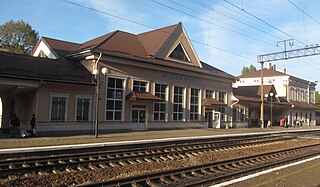
A diesel multiple unit or DMU is a multiple-unit train powered by on-board diesel engines. A DMU requires no separate locomotive, as the engines are incorporated into one or more of the carriages. Diesel-powered single-unit railcars are also generally classed as DMUs. Diesel-powered units may be further classified by their transmission type: diesel–mechanical DMMU, diesel–hydraulic DHMU, or diesel–electric DEMU.

Transport in Ukraine includes ground transportation, water, air transportation, and pipelines. The transportation sector accounts for roughly 11% of the country's gross domestic product and 7% of total employment.

An oblast in Ukraine, sometimes translated as region or province, is the main type of first-level administrative division of the country. Ukraine's territory is divided into 24 oblasts, as well as one autonomous republic and two cities with special status. Ukraine is a unitary state, thus the oblasts do not have much legal scope of competence other than that which is established in the Ukrainian Constitution and by law. Articles 140–146 of Chapter XI of the constitution deal directly with local authorities and their competency.

InterCity is the classification applied to certain long-distance passenger train services in Europe. Such trains generally call at major stations only.

Hyundai Rotem is a South Korean company that manufactures rolling stock, defense products and plant equipment. It is a part of the Hyundai Motor Group. Its name was changed from Rotem to Hyundai Rotem in December 2007 to reflect the parent company.

Elektrichka is a Soviet and Eastern bloc commuter (regional) mostly suburban electrical multiple unit passenger train. Elektrichkas are widespread in Russia, Ukraine and other countries of the former Warsaw Pact presenting a socially vital mode of transportation. In 2007, 4085 commuter trains a day were running on the Russian Railways network alone, most of them electric. The first elektrichka train on July 6, 1926, along the Baku–Sabunchi line in Soviet Azerbaijan. Also urban (intra-city) gorodskaya elektrichkas and airport's aeroexpresses exist in a few cities of Russia, Ukraine, and Belarus.

Ukrainian Railways is a state-owned joint-stock company administering railway infrastructure and rail transport in Ukraine; a monopoly that controls the vast majority of the railroad transportation in the country. Ukrainian Railways is the world's 6th largest rail passenger transporter and world's 7th largest freight transporter. As of 2020, the total length of the main broad-gauge railroad network was 19,787 kilometres (12,295 mi), making it the 13th largest in the world. Ukraine also has many stretches of standard-gauge railway (1,435 mm), and is currently working to expand these in order to improve its connections to the European Union.

Kyiv-Pasazhyrskyi is a railway station in the capital of Ukraine, Kyiv. The station is a railway hub consisting of several railroad station buildings, along with its own repair facilities the Kyiv Electric Railcar Repair Shop, a railway depot with railyard, and the railway sports complex, which is integrated into the cityscape. The station is part of the so-called Kyiv Southern Railway loop.

Rail transport in Ukraine is a mode of transport by railway in Ukraine. Most railway infrastructure transport in Ukraine is owned by the government of Ukraine through Ukrzaliznytsia, which has a country-wide monopoly on passenger and freight transport by rail. Part of the rail network in eastern Ukraine was privatized in the late 1990s, creating the biggest private railway company in the country, Lemtrans, which focuses on freight transport.

Darnytsia is the largest Ukrainian Railways station of the Ukrainian capital Kyiv, located in the city's Left-bank Darnytsia area.

The Class 471 electric motor unit, commonly known as CityElefant, is a double deck electric multiple unit operating on 3 kV DC overhead wires produced by Škoda Vagonka, a subsidiary of Škoda Transportation, since 1997 and operated by the České dráhy rail transit operator on its suburban services around Prague and Ostrava, Czech Republic. A single unit consists of a Class 471 power car with first class seating, a single Class 071 passenger car and a Class 971 cab car. They are replacement for defunct ČD Class 451, and successor to scrapped ČD Class 470.

The Class 91 is a type of electric multiple unit currently operating on Keretapi Tanah Melayu's Electric Train Service (ETS) since 2009. KTMB purchased a total of 5 sets worth RM 240 million from a joint venture between South Korea's Rotem Co. and Japan Mitsubishi Electric Corp in 2008. Each set has six coaches.

The Kyiv City Express is an urban rail transit passenger service in Kyiv, Ukraine. The service is operated by Ukrainian Railways and Kyivpastrans. The project uses a long-existing railroad ring in the city for peak hour circulation of electric multiple unit trains.
EJ 675 is a double-decker electric multiple unit by Škoda Vagonka a subsidiary of Škoda Transportation, operated by the Ukrainian state railways Ukrzaliznytsia. It is a variant of the Czech Railways class 471 "City Elefant" adapted for 1,520 mm gauge railways.

Pidzamche railway station is a railway station of the Lviv Railways located in Lviv, 7 km away from the city's main railway terminal. Officially considered a freight station, it is nevertheless served by all passing suburban trains, as well as several long-distance trains.

Dnipro-Holovnyi is the main railway station of Dnipro. Dnipropetrovsk Oblast, Ukraine.

Chortkiv railway station is a nodular cargo and passenger station in the town of Chortkiv, Ukraine. Chortkiv station is situated on the railway line Ternopil - Chernivtsi. The station serves freight and passengers.

The Territorial Defence Forces are the military reserve component of the Armed Forces of Ukraine.

DPKr-3 is a Ukrainian diesel-powered regional train manufactured by the Kryukiv Railway Car Building Works. The first unit, built in 2019, ran between Kyiv and Boryspil Airport on the Kyiv-Boryspil Express airport rail link until September 2020, after which it became an express service on the Smila - Cherkasy line. The second and third unit was built in 2021 and commissioned in October. The fourth is going through testing since the 12 of November.



























